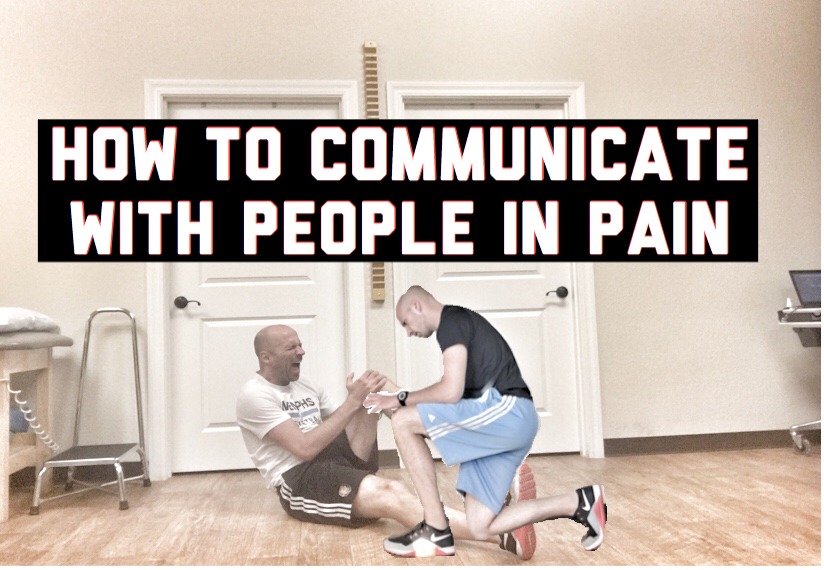Communicating with people in pain is a tricky situation.
If you say the wrong thing, or act afraid amidst pain, negative consequences will ensue with your client.
So what is a clinician or coach to do when talking with a client? Are there better word choices to make when communicating with someone in pain?
If you have these questions, then check out this week’s podcast and post. I provide some suggestions to help communicate with your people in pain, which will help them reach their goals.
Enjoy!
Table of Contents
How To Communicate with People in Pain
In order to understand why words are important when someone is experiencing pain, we first have to understand what pain is. Pain is an output produced by the brain in response to an actual or potential threat. If the brain decides that one needs to be protected in an area, pain will be produced.
Anything can be a threat. You can have an actual or potential tissue damage be a threat. You can have a systemic problem be a threat. You can have an environmental factor be a threat. And you can most certainly have words be a threat. This reason is why the words that we used with an individual are important.
What pain is not, is a marker of tissue damage. Oftentimes, these two things can be synonymous with one another because sometimes tissue damage can lead to an appropriate amount of pain.
Conversely, there are many cases in which injury and pain do not match. You can have pain produced when tissue damage is not present. Think about a pebble stuck in your shoe. As an example of that. You can also have tissue damage and not necessarily perceive pain. Think about a time in which you were out in nature, when suddenly you notice you are bleeding because you scraped yourself against a brush. You may not have felt pain when that happened, but it’s clear that tissue damage is present.

We can see that pain and tissue damage do not always correlate. We want to make sure that the language we use around patients reflects that, and makes certain that the person understands that the pain can be something that’s within their control, and does not necessarily mean that they’re damaged. This knowledge can promote an environment that does not increase threat.
Nonthreatening Pain Language
We must not use threatening language. If we hear our clients saying things like “a crushed disk,” “I’m broken,” “I damaged my elbow” “I have a back problem,” or other harsh-sounding things, we must do what is in our power to expel these words from our client’s vocabulary. I don’t even like someone saying problem.
[Side note: if you want a more in-depth explanation as to why these are no bueno, sign up for my newsletter to get access to my pain talk]
[yikes-mailchimp form=”1″ submit=”Yes, I’d like a 90 minute talk on all things pain.”]
All of these words are often related to anatomical issues. Anatomical issues do not always correlate with pain and cannot be changed or expedited unless it is done so surgically.
What we can do is change some of the other processes that can contribute to a pain experience that would be a threat. If you are out of shape and pushed towards your fitness limits, that could be perceived as a threat that leads to pain. But if fitness improves, then those things which were offending early on may not be later on.

We want to use language that gives our clients a locus of control in terms of their pain experience. Damage, crushed or slipped discs, joints going out do not help our cause.
Words that we should use with people should be things like “trouble.” “Trouble” implies that this is not going to last forever. I also like using the same descriptor that the client uses if said descriptor is not deleterious. They might say “I have a backache.” Instead of saying “How’s your back pain?” I would say how’s your backache. Using the words that the client uses will help them feel understood and be more receptive to what you have to say.
I’ve had many times where I’ve had someone say backache and I’ve said “How’s your back pain doing?” and they might say “well it’s not pain, it’s more like an ache” and sometimes they can get a little defensive. If you want your clients to feel understood, use their descriptors.If their descriptors are negative, then you want to educate them on why that word is not the best or most accurate choice.
Discouraging Disembodiment
We must also be mindful of describing the area in question. Namely, I do not encourage people asking how’s the body part. For example, you don’t ask “how’s the back?” or “how’s the shoulder?” The reason why you don’t do this is because it encourages disembodiment of the painful area.
In chronic pain, the representation of the painful area in the brain becomes less clear. It becomes smudged. It essentially stops being a part of that person. We do not want to utilize words that perpetuate that problem.
When you say “the back,” it implies that the hurt area is not a part of that person. As inspired by Seth Oberst, if we consider a body region not a part of us, then we are less likely to trust that area. If we do not trust an area, then that area will be perceived as more threatening. Remember. If we are perceiving threat, pain can be produced to protect the area. If we do not trust the area that’s hurting, how can we ever get over our pain experience?
Instead of saying the back or the shoulder, we want to encourage our clients to say “my shoulder” or “my back.” The way we do this is by asking “How’s your back during that exercise? “How’s your back feeling today?” or even better “how are you doing today?”

We are greater than the sum of our body parts, and we also want to make sure that our body parts stay a part of us.
We must discourage “the.” To do so, tell your clients that the injured area is a part of them that must be trusted if they want to get better. Using language such as the can increase pain. You got to love the area that’s hurting you before we get you better.
When a client says an exercise is painful
Another strategy that I like to use with clients who are in pain is asking clarification. What do you mean by that?
Let me give you an example. I had someone with knee pain perform tempo squats, and they told me: “mmmm that hurt! That hurt so much!!” Instead of freaking out, I maintained a calm demeanor and I asked “What do you mean by that?” Upon asking for clarification, the client said that they felt pain in their quads and in their glutes. I then asked if they had any knee pain during, and they responded with a no.
Praise the lord!

I can then go on to educate and say that’s actually a good pain. That pain signifies that your tissues are becoming more resilient. Healthy. Healthier and more resilient tissues mean less pain for you because the fitter you are, the fewer things are perceived as threat.
Getting clarification allows us to de-threaten any potentially threatening language or scenarios that are not in reality as such.
We can even mitigate this problem beforehand by informing the client that symptoms ought not be produced during any activities. What instead should be felt is a good work out in desired areas. These muscles should be working, and your symptoms should not be increased.
Sum Up
Language can oftentimes be threatening, and contribute to one’s pain experience. Thus, we must adapt favorable language that does not encourage maladaptive beliefs.
To summarize my favorite strategies:
- Encourage use of pain descriptors that emphasize locus of control, not anatomical misinformation.
- Describe the injured area as a part of the client. Use “your” and “my,” not “the.”
- Ask for clarification to reduce the odds of making an activity come off as threatening.
What pain descriptors do you like to use to reduce threat perception? Comment below and let us know!



